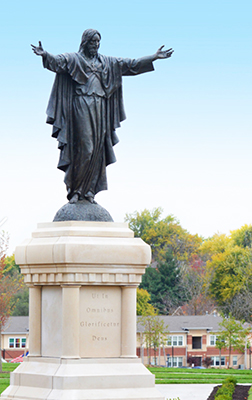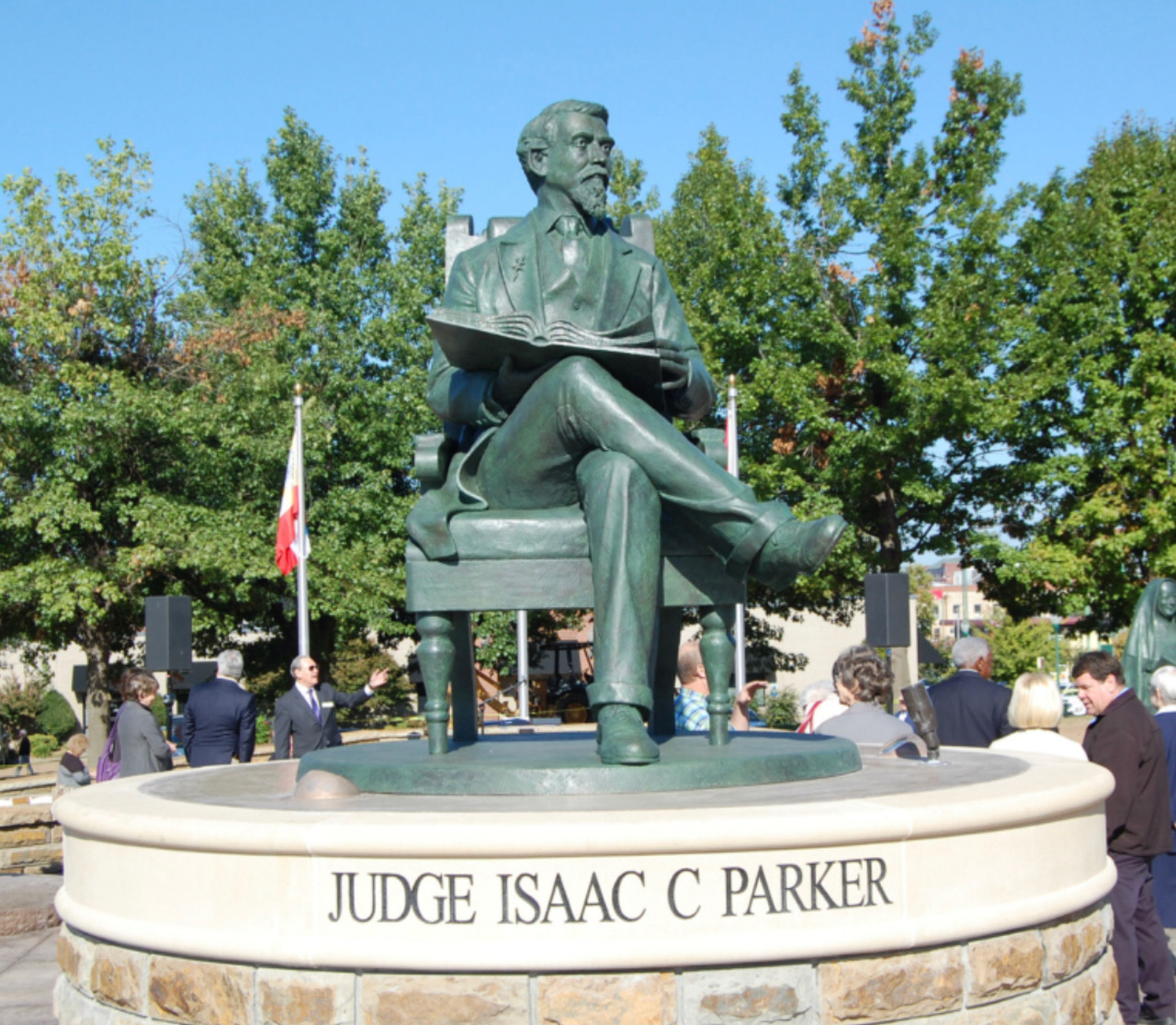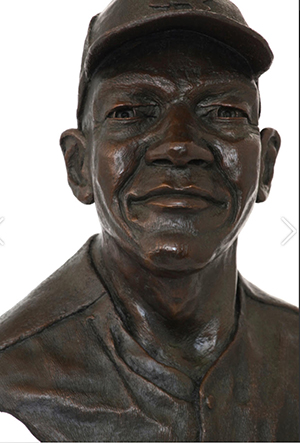E.S. Spencer Schubert: An Artist’s Path to Portraiture in Bronze
 Sacred Heart of Jesus by E.S. Sculpture Studios.
Sacred Heart of Jesus by E.S. Sculpture Studios. Photograph courtesy of E.S. Schubert Studios.
In 2004 American artist and sculptor E.S. “Spencer” Schubert decided it was time for him to try to fail at being an artist for a living rather than contemplate how he was going to succeed. He figured if he did fail, he could move on to something else. But that wasn’t necessary because fifteen years later, his business, E.S. Schubert Sculpture Studios, centered on creating traditional figurative bronze sculptures, still stands and is thriving.
“I always had a dream of waking up in the morning and having a cup of coffee and making things all day for a living,” he says, recalling time spent as a kid at his work bench in the basement of his family home where he was always creating things.
Schubert, who grew up and still lives in Kansas City, Missouri, was a musician and had a background in silversmithing before switching his focus to bronze.
“I switched scales and alloys,” he says. “I started making big things out of bronze as opposed to little things out of silver.”
He has learned many lessons over the years while on his artistic journey that he’s enthusiastic to share with aspiring sculptors. Schubert feels strongly that the most important thing for those looking to pursue a profession in his field is to first focus on acquiring the skills necessary to pull off the process.
“I think there is a lot of focus on trying to find the truest expression of their creative heart when what they should focus on is how to do it well,” he says. “It’s putting the cart before the horse.”
 Judge Isaac C. Parker by E.S. Schubert Sculpture Studios.
Judge Isaac C. Parker by E.S. Schubert Sculpture Studios.Photograph courtesy of E.S. Schubert Studios.
Schubert believes that good craft will always help bad design, but explained it doesn’t work the other way around.
“If your solder seams are full of pits, nobody will ever believe that is your creative choice,” he says.
Overall, he sees that very few people focus and invest the time needed to do something really well these days. Through personal experience he has come to learn that repetition, intention and time are the keys to learning and perfecting a craft.
“Our culture isn’t set up to support people who spend a lot of time on doing one specific craft,” he says. “It needs to be worthwhile for you to do it even if you don’t get recognition for it. Eventually our culture will reward you for your mastery if you stay on that path.”
But Schubert was willing to admit that the circumstances behind him getting his very first commission weren’t initially based on the skills he had acquired. It opened his eyes up to the reality of securing such relationships.
“I got it because of my connections and relationships, not because of my skill,” he recalls. “The reality is that people like to do business with their friends.”
The piece was a portrait bust of a famous Missourian to be on view at the state’s capitol. Despite the connection, Schubert still had to spend a year lobbying for the project and prove he was capable and qualified to take it on, despite his lack of previous commission work.
“When you are young and hungry, you have to do things you wouldn’t do when you’re old -- you have to do way more than called for and exceed expectations,” he says.
Going out of his way to secure the project proved worthy and has impacted his career in positive ways ever since, particularly with regard to a greater ease in getting commissioned work. To this day, most of E.S. Schubert Sculpture Studios’ work is gained through word of mouth.
“Once you have one commission, it’s easy to get the second one,” Schubert says. “At that point I was the guy who worked at the state capitol and who was good enough for your business’ lobby.”
Schubert’s road to portraiture equated to exploration of the human body through first sculpting hands before moving onto faces.
“The only way to learn how to do portraiture or landscape painting is to be alone by yourself for hours and do it over and over and over again,” he says. “Instructionally, not a whole lot can be done -- the only way to learn is by doing and being your own worst critic but also your own fiercest ally.”
He has learned that one’s self-talk has to be balanced.
 Baseball legend Buck O’Neil, Hall of Famous
Baseball legend Buck O’Neil, Hall of Famous Missourians, Capitol Building, Jefferson City, Missouri
by E.S. Schubert Sculpture Studios.
Photograph courtesy of E.S. Schubert Studios.
“They need to be a driving task master and a nurturing soul to get to the point where they can make a portrait to look kind of like a person,” he says. “They have to never stop trying to get better.”
The bulk of Schubert’s work right now is requests for busts. Prior he found requests coming in for Civil War Confederate monuments.
“The world and the media was focused on it,” he says, adding some individuals wanted to replace some monuments that were taken down. “We declined those requests.”
In the past twelve months, requests have shifted to a desire to represent marginalized populations.
“We have been getting asked about projects where people are considering the fact that minorities of all kinds are misrepresented in sculpture,” he says. “They want to reflect the diversity of this world and that is a nice, refreshing shift that they want to do a little more to balance that scale.”
Other shifts going on in the realm of sculpture have to do with shrinking budgets that have impacted the scale of most of Schubert’s projects ever since the pandemic took hold of the world.
“In the beginning of 2020 we had three or four projects that would have been monumental and those have dried up,” he says. “Things on the lower end of the cost spectrum have continued.”
His 2,500 square foot studio, located just one and a half blocks from his home, is equipped to accommodate projects of all scales.
 Bronze artist E.S. Spencer Schubert in his studio.
Bronze artist E.S. Spencer Schubert in his studio. Photograph courtesy of E.S. Schubert Studios.
“There is a space where I sculpt portraits and that opens up into the larger shop where I have a hydraulic lift table that I sculpt monuments on,” he says.
Schubert learned how to cast bronze when he was in college at the University of Kansas where he was studying on a silversmithing scholarship.
“It’s the only real choice for sculpture to be outside and last for hundreds of years,” he says.
“Bronze alloys have proven themselves over the millenia. If you cast it in bronze, I’ll guarantee it for 300 years.”
When it comes to the care of sculptures, Schubert guides his clients through what is a relatively easy process to aid in its preservation. If a sculpture is on public view at a college or university, for example, they will show the ground maintenance staff how to preserve it.
“It’s not difficult if you stay after it on an annual basis,” he says. “Every year during the summer you rinse off the sculpture, let it dry and then put a coat of paste wax on it.”
If the sculpture has accumulated a lot of bird droppings, he recommends using a non-abrasive brush to give it a gentle scrub during the rinse-off process. One tip he gives to avoid scratching the patina on a piece is to wrap the ferrule of the brush with a piece of masking tape prior to applying the paste wax.
“Paste wax is an amazing protectant,” he says, saying he recommends it versus the use of an acrylic clear coat. “It’s kind of like waxing your car -- it’s a hard wax with a solvent in it.”
The reality, however, is that Schubert finds most clients don’t follow his annual maintenance recommendation and are more likely to apply the paste wax every other year.
“We are lucky in that bronze is such an incredible metal,” he says. “If you forget it for ten years it’s probably still salvageable. It should last in perpetuity if you put it on on an annual basis.”
The patina that forms that’s synonymous with the aging of bronze sculptures is an attribute that Schubert highly appreciates.
“An aged patina is so rich and beautiful in and of itself and it’s protecting the metal underneath,” he says.
Another aspect of bronze he appreciates is how well it pours in comparison to other metals, regarding it as ‘the only real choice’ when making outdoor sculpture that is cast. He also shared an aspect that he doesn’t care for about the copper alloy.
“From point A to finish there are so many iterations to get to the end product,” he says, “But, the benefit to casting something in bronze and having it last thousands of years under the sea -- there is no competition there.”
Resources:
Also in this Issue:
- E.S. Spencer Schubert: An Artist’s Path to Portraiture in Bronze
- Modern Gothic: The Inventive Furniture of Kimbel and Cabus, 1863–82 Opens at Brooklyn Museum
- Paul Dempsey: Pushing the Boundaries with Copper
- Richard Hunt: Returning to His Roots
